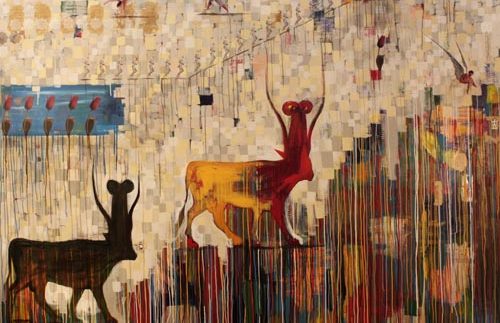-
6 Brazil Street
-
Galleries
-
-
Mon - Sat, 10 am - 2 pm & 5 - 9 pm
Soraya Morayef

Egyptian artist Khaled Hafez’s latest exhibition launched at
Safar Khan Gallery in Zamalek this Tuesday, January 10th. Titled ‘On
Codes, Symbols and the Stockholm Syndrome’, the exhibition showcases twelve
paintings, most of which are large, imposing pieces, in the gallery’s confined
space.
Layered, nuanced and subtle, the paintings are full of
symbolism – as the exhibition name promises – and are aesthetically alluring.
The artworks combine ancient Egyptian symbols with contemporary beauty
stereotypes, bridging traditional Egyptian codes with Western pop culture; the
holy and untouchable with the ephemeral. These symbols are recurrent themes in
his previous projects; in fact, Hafez is known for his use of layers, dripping
and fashion magazines cut-outs that
juxtapose beautifully with Pharaonic symbols.
According to his blog, Hafez sought to explore what it means
to be Egyptian. In doing so, he integrated dripping colours with running
robotic bodies, cut-outs of fashion models, the Pharaonic cow goddess Hathor,
the lioness goddess Sekhmet and the Eagle of the Egyptian flag. All paintings
are heavily layered, some with white and grey cubes, others with dripping of bright
colours, over which the cut-outs and images are imposed.
Take your time exploring the paintings; this is not an
exhibition that shoves its message and meanings down your throat. Hafez is making a nuanced and subtle commentary on Egypt’s
social and political issues. The Eagle of Saladin, for example, appears inconspicuously
in several pieces, and according to the artist’s bio, ‘represents the present
state of the country and criticising those in power.’
Two paintings carrying pop
art images of Om Kolthoum are placed above each other at the front of the space. The first, titled Stockholm Kalsoom shows six cut-out
images of the iconic singer carrying her famous handkerchief over a layer of
white and grey cubes. The singer and her handkerchief are poignant symbols in
Egypt’s pop culture and history, and it’s interesting how the first cut out is
a dark shadow, like an outline or a ghost of the national icon.
The cow goddess Hathor is the most prevalent symbol in the
exhibition, featured in at least four paintings, including Two Stockholm
Hathors & One Nute, where the outline is framed by the Ma’at crown.
Hathor represents maternity, sensuality and a willingness to sacrifice for
others, while the crown represents justice. This could be a representation of
the nation or the spirit of Egypt. In one corner, several red tulips grow out
of a blue background, as a line of robotic runners crawl diagonally towards the
top corner. According to Hafez, the runners symbolise flight of power, identity
and even faith. A very subtle element is the recurrence of the Islamic star in
the far left corner, a reference to the right-wing religious stream of thoughts
dominating society recently.
This reviewer found the most poignant element in the
painting to be the cut-out image of a woman in an acrobatic position. Her upper
body is severed from her lower and in between is a flow of white paint that
could represent water or movement. There’s something beautiful, nostalgic and
haunting about this tiny, frail image, one that remained on this reviewer’s
mind long after leaving the exhibition.
Hafez’s latest collection is layered with symbols and heavy
with emotional references, much like the past year in Egypt. If you’re a fan of
Hafez’s work or appreciate abstract collage art, this exhibition is worth a
visit.
Write your review
recommended
 Restaurants
Restaurants
Cairo's Ramen Revival: 5 Must-Try Bowls Around the City
Asian Food Asian Restaurants Cafés
Cafés



